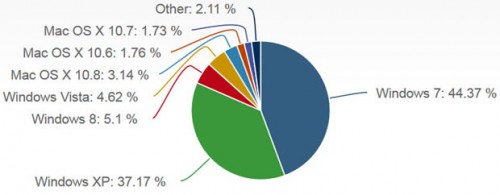FOSS Week in Review–Part 1
We’re making up for lost time. We took last week off to celebrate the Fourth (any excuse for a party), so this week you get more bang for your buck. To paraphrase the Doublemint Twins, you get two, two, two weeks in one!
Windows 8 now used by more people than Vista
Something tells us this is a milestone Steve Ballmer wishes we’d keep quiet about, but last week we learned from CNET that Windows 8 is now on more computers than Vista. It took eight months, but as of June, the installed base of Redmond’s latest has now passed that of Vista, probably the least popular operating system in Microsoft’s history.
Mr. Ballmer probably also doesn’t want us reminding you this doesn’t mean that sales of Windows 8 have now outpaced sales of Vista. Although we don’t know for sure, we can only assume that Vista still has more total sales. Remember, Vista was so unpopular that many people bought boxes with Vista, only to take advantage of the rollback feature that allowed users to go back to the future and magically turn Vista into XP. Also, many Vista users immediately upgraded to Windows 7 as soon as it was released, when reviewers pronounced it didn’t suck as bad as Vista.
In other words, more people are using Windows 8 now than are using Vista now, but the Redmond gang probably still has miles left to go before total sales of the OS with the UI formally known as Metro outpaces sales of Vista. Does this mean that Windows 8 is even less popular than Vista? Not according to Mr. Ballmer. He’d like you to know that Windows 8 is like Dan Quayle–still gaining acceptance.

The 8 ball is now the number three OS, behind Windows 7 and XP. Far behind, we might add. According to Net Applications, second place XP currently commands 37.17% of installations compared with 5.1% for Windows 8. If 8 can keep up this pace, they should be able to surpass XP well before the year 2020.
IRS targets open source for denial of nonprofit status
We also learned last week that the Tea Party isn’t the only group being singled-out by the IRS for special treatment. According to an article published by Wired, documents released by Congress disclose that since 2010 or before, the IRS has given special scrutiny to applications from open source organizations for nonprofit status.
“According to the documents, open source projects have been flagged by the tax agency’s Be On the Look Out, or BOLO, list. This means they received extra scrutiny from the IRS — just like the Tea Party, some progressive organizations, and medical marijuana groups — when they applied for certain types of federal nonprofit status.”
Evidently the IRS is concerned that some open source projects are in fact merely software vendors. According to a former IRS field agent with personal experience dealing with OSS projects who emailed Mother Jones regarding this matter:
“Fundamentally, it’s the same story that the Tea Party organizations have faced: the IRS has a reasonable question about the legitimacy of some of these groups, but they lack the resources to actually resolve those questions, so instead they just cast a massive net and catch everyone. The fact that this is hitting something as nonpartisan as software organizations should really drive home the point that this is all driven by structural problems at the IRS, rather than political scare tactics.”
Bradley Kuhn, Executive Director of Software Freedom Conservancy, says the IRS might be stuck between the proverbial rock and hard place. He points out there are many open source projects that don’t really qualify for nonprofit status. However, he adds, “They’ve painted a lot of different types of organizations with a broad brush, in part because I don’t think they really understand how open source and free software work.”
Meanwhile, the IRS is promising to do better job in the future. We’ll see…
Another Finnish startup to offer $1,300 Android phone
Here’s an item that might upset the apple cart, especially for those of you who like to think of Android as the iPhone’s cheaper sister. It seems that another group of laid off Nokia employees has gotten together to form a smartphone company. Sixteen out-of-work Nokia folks have formed Adaia and plan to bring a line of phones running Android to market sometime next year. When they are launched, don’t expect to pick one up on the cheap when you sign a two year contract, as these babies are going to be priced from $1,300 on the low end to $6,500 on the high end.
You might ask what you get for that kind of dough. Like Will Rogers, all we know is what we read on Engadget, and all they can tell us is something about “extra ruggedness and durability as well as potential satellite connectivity.” There aren’t any pictures yet, but we understand they’ll feature a 4.8″ screen and will have the ability to hot swap batteries without the need to power down. They’ll also be heavy, weighing in at about a half pound.
Well, that does it for our review of the week of July 4th. We’ll be back this afternoon with our review of this week’s news. Until then, may the FOSS be with you…








